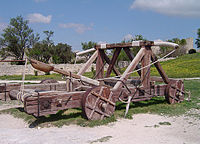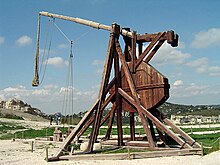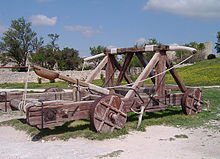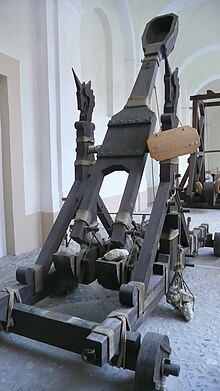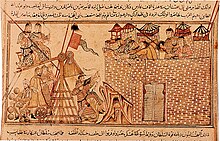Catapult
A catapult is an instrument of war used in ancient times to launch large objects from a distance as projectiles. It was probably invented by the engineers of Dionisio I of Syracuse, approximately in 400 BC. C. and later improved by the Carthaginians and Romans, and was widely used in the Middle Ages, until, with the introduction of gunpowder, it became obsolete.
The catapult was created primarily to break down enemy walls and storm castles. The first catapults were used far from where they were built, which forced the creators and engineers to work on their shape, weight, size, design, and mobility, since they were necessary weapons in great combat. In this way, it was possible to obtain a catapult that was easier to handle and move, which could participate in battles.
These devices are also known by the Latin name velopoietica. The largest models were mounted on strong wooden platforms; the trigger or driver of this type of crossbow was tightened by means of ropes until it was attached with a hook. Another type of catapult applied the principle of torsion to launch stones or heavy objects over walls and moats: ropes wound with winches to pull back the drive mechanism. Also were used smaller catapults, that were portable. See Fortifications.
Earlier catapults had a spoon-shaped arm at the end to position and launch the projectile, but later versions before the widespread use of gunpowder made them obsolete used a slingshot to launch the projectile.
The most effective type of catapult was the trebuchet or almajaneque, which worked by the force of gravity. A counterweight was raised by means of ropes, and once the projectile was located, the ropes were released and the counterweight, heavier than said projectile, launched it.
The first catapults were in the form of a huge slingshot planned by Alexander the Great and his engineers to bring down the walls of the Achaemenid empire. The Greeks had a huge sling that shot large arrows by means of elastic cords. Later that model was modified to achieve stone throwing using the energy of elastic cords plus the energy of other tension cords.
Greek and Roman catapults
The catapult and the crossbow in Greece are closely related. Early catapults were essentially "the product of relatively simple attempts to increase the range and penetrating power of projectiles by reinforcing the arc that propelled them". The historian Diodorus Siculus (fl. century I BCE), described the invention of a mechanical catapult that fired arrows (katapeltikon) by a Greek task force in the year 399 a. The weapon was used soon after against Motya (397 BC), a key Carthage stronghold in Sicily. Diodorus is supposed to have drawn its description from the highly valued history of Philistus, a contemporary of the events of then. The introduction of crossbows, however, can be dated further back: according to the inventor Hero of Alexandria (fl. century I d. C.), which referred to the works, now lost, of the engineer of the III century a. C. Ctesibius, this weapon was inspired by an earlier foot-supported crossbow, called gastrafetes, which could store more energy than Greek bows. A detailed description of the gastrafetes, or the "belly bow,", along with a watercolor drawing, is found in Heron's technical treatise Belopoeica.
A third Greek author, Bithon (fl. II century BCE), whose reliability has been positively reassessed by recent studies, he described two advanced forms of the gastraphetes, which he attributes to Zopyros, an engineer from southern Italy. Zopyrus has plausibly been equated with a Pythagorean of that name who seems to have flourished in the late V century BCE. C. He also made it from Camp.He probably designed his arch machines on the occasion of the sieges of Cumae and Miletus between 421 BC. C. and 401 B.C. C.. The bows of these machines already had a recoil system with a winch and, apparently, they could launch two projectiles at the same time.
Philo of Byzantium probably provides the most detailed account of the establishment of a theory of belopoetics (belos = "projectile"; poietike = & #34;(art) of making") around the year 200 BC. The central tenet of this theory was that "all parts of a catapult, including the weight or length of the projectile, were proportional to the size of the torsion springs." This type of innovation is indicative of the increasing rate with which geometry and physics were being assimilated into military enterprises.
From mid-century IV a. C., the evidence of the Greek use of arrow-throwing machines becomes denser and more varied: arrow-throwing machines (katapaltai) are briefly mentioned by Aeneas the Tactician in his treatise on the art of siege written around 350 B.C. An extant inscription from the arsenal of Athens, dated between 338 and 326 BC. C., lists a number of catapults stocked with variable-size firing bolts and tendon springs. The last entry is particularly noteworthy, as it constitutes the first clear evidence of the shift to more powerful torsion catapults. than the more flexible crossbows and came to dominate Greek and Roman artillery design thereafter. This move to torsion springs was probably stimulated by the engineers of Philip II of Macedon. Another Athenian inventory of the 330 to 329 BC includes catapult bolts with heads and flights. As the use of catapults became more common, so did the training required to operate them. Many Greek children were instructed in the use of catapults, as evidenced by an inscription from the III century BCE. from the island of Keos in the Cyclades [regulating] catapult shooting competitions for young men". Arrow-firing machines are reported in action by Philip II at the siege of Perinthus (Thrace) in 340 BC At the same time, Greek fortifications began to feature tall towers with barred windows at the top, which might have been used to house anti-personnel arrow shooters, as at Aegostena. The projectiles included both arrows and (later) arrows. stones that sometimes lit up. Onomarchus of Phocis first used catapults on the battlefield against Philip II of Macedon. Philip's son Alexander the Great was the next commander in recorded history to make such use of catapults on the battlefield, as well as that he used them during sieges.
The Romans began using catapults as weapons for their wars against Syracuse, Macedonia, Sparta, and Aetolia (III and 2nd century BC). The Roman machine known as an arcuballista was similar to a large crossbow. Later, the Romans used ballista catapults on their warships.
Medieval catapults
Castles and fortified walled cities were common during this period and catapults were used as a siege weapon against them. In addition to their use in attempts to breach the walls, incendiary missiles, or diseased corpses or garbage could be catapulted over them.
Defensive techniques of the Middle Ages progressed to the point where catapults were largely ineffective. The Viking siege of Paris (AD 885-6) "saw the use by both sides of virtually every siege instrument known to the classical world, including a variety of catapults", to little effect, resulting in failure.
The catapults most used throughout the Middle Ages were the following:
- Ballist
- The ballists were similar to the giant crossbows and were designed to function by torsion. The projectiles were large arrows or wooden darts with iron tip. These arrows were shot "through a flat path" towards a target. The ballists were precise, but they lacked the firepower of a mangonel or a trebuchet. Because of their immobility, most of the ballists were built on-site after a siege assessment by the commanding military officer.
- Torsion sword
- The design of the torsion espingarda resembles that of the ballist, being a ballesta driven by tension. The crossbow frame was more compact, allowing its use in smaller spaces, such as the interior of a castle or a tower, but compromising its power.
- Mangonel
- This machine was designed to launch heavy shells from a "cot-shaped cover at the end of your arm." The mangonels were mainly used to "dispare several missiles against fortresses, castles and cities", with a range of up to 1300 feet. These shells included stones to excrements or decomposition bodies. The mangons were relatively simple to build, and over time they were added wheels to increase mobility.
- Onagro
- The onagro catapults initially launched projectiles from a funda, which later changed by a "cot-shaped cover". The word Onager derived from the Greek word onagros for "savage ass", referring to the "movement and skating force" that were recreated in the Mangonel design. The historical records on the onagros are scarce. The most detailed account of Mangonel's use comes from the "translation of Eric Marsden from a text written by Ammianus Marcellius in the fourth century AD." which describes his construction and use in combat.
- Trebuchet
- The trebuchets were probably the most powerful catapult used in the Middle Ages. The most commonly used ammo was the stones, but they could be replaced by "darts and sharp wooden sticks" if necessary. However, the most effective type of ammunition was fire, such as "the fire bars and the deadly Greek fire." The trebuchets had two different designs: traction, which were driven by people, or counterweight, in which people were replaced by "a weight in the short end". The most famous historical account of the use of trebuchets dates back to the siege of the Stirling Castle in 1304, when the army of Eduardo I built a giant trebuchet known as Warwolf, which then proceeded to "draw a section of the wall [of the castle], successfully concluding the siege".
Couillard: A simplified trebuchet, in which the trebuchet's sole counterweight is divided, swinging on either side of a central supporting post.
- Catapulta by Leonardo da Vinci
- Leonardo da Vinci tried to improve the effectiveness and scope of previous designs. Its design incorporated a large wooden crossbow as a builder to boost the catapult.[chuckles]required] Both ends of the arch are connected by a string, similar to the design of an arch and arrow. The crossbow was not used to pull the armor from the catapult directly, but the rope rolled around a drum. The catapult armor was attached to this drum, which was rotated until enough potential energy was stored in the deformation of the dock. Then the drum was untangled from the rolling mechanism, and the arm of the catapult was slammed. Although there is no evidence that this design was built in Leonardo's life, contemporary enthusiasts have reconstructed it.
Contenido relacionado
Gran Via station
Protectorate
Celtic languages
